-
Software
-
CAM software
- Tebis Automill
- CNC programming
- CNC automation
- CNC simulator
- Multiple setup
- Robotic machining
- CNC drilling
- Deep-hole drilling
- Combined turn-milling
- CNC turning
- Turn-milling
- 2.5D milling
- 3D milling
- 5-axis milling
- Slot milling
- Trimming
- HPC milling
- HFC milling
- Circle-segment cutters
- Sinker EDM
- Wire EDM
- 3D laser cutting
- Laser hardening
- Laser weld cladding
- CAD software
- CAQ software
- MES software
- Products
- Stories about parts
-
CAM software
- Services
- Consulting
- Sectors
- References
- Company
- News

-
 Home References
Home ReferencesA reliable partner right from the start
Founded in 2003, Kestermann Modell- und Formenbau has roots in foundry model manufacturing.
Since then, the client portfolio has grown considerably, as has the variety of products.
Tebis was our CAM system of choice from the very beginning.
And in all the years since, it has flexibly and consistently guided and supported us through the various changes and growth at our company based in Emsdetten in the Münsterland region of Germany.Company
Kestermann GmbH & Co. KG
Location
Emsdetten
Focus
Model manufacturing / mold manufacturing / prototyping / contract manufacturing
Benefits:
- Tebis modules (e.g., 5-axis milling, trimming module, 3+2-axis milling, 2.5D element) ensure a high level of precision and productivity.
- Automated programming of routine tasks using features and templates in Tebis 4.1
- Libraries (tools and clamping devices) enable automated programming
- Color coding simplifies CAD data processing
- The digital twin / virtual machine ensures safe machining
Sector
Mold manufacturing
Model making
Published
2024

Interviewee: Christoph Kestermann, Managing Director of Kestermann GmbH & Co KG
Kestermann manufactures a very wide range of parts.
At the company in Emsdetten, Germany, the model and mold-making specialists can handle dimensions ranging from 100 x 100 x 100 mm to 7000 x 3500 x 1750 mm. In terms of materials, the machinists use almost everything on their machines, from wood to relevant model and mold-making plastics, as well as a wide range of aluminum alloys and common tool steels.
The wide range of geometries, dimensions, and materials requires a high degree of flexibility from the operators and the machinery. In addition to a recently acquired Zimmermann 5-axis FZ37 CNC gantry milling machine, they also have a 5-axis FPT Dinomax 2 CNC gantry milling machine, a 5-axis FPT Stinger 180 vertical machining center, an FPT Raid XL vertical machining center, and two Hermle universal 5-axis machining centers (C32 U and C52 U). The machines are all equipped with grids and zero-point clamping systems, which lays a solid foundation for automating processes, speeding up setup, and making machining more precise and repeatable.
Tebis version 4.1, has become a great deal faster than version 4.0.
Christoph KestermannKestermann GmbH & Co. KGRoots in foundry model manufacturing
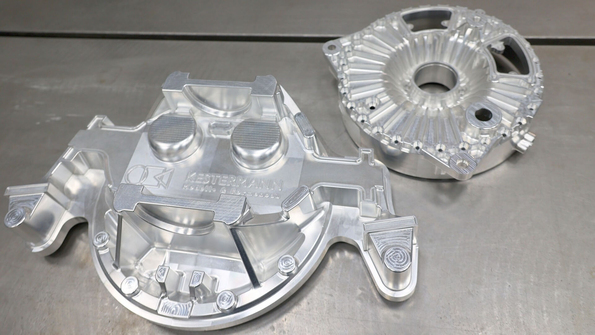 Founded in 2003, Kestermann Modell- und Formenbau has its roots in foundry model manufacturing. Even back then, Tebis was our CAM system of choice. The client portfolio and variety of products have grown considerably. – Photo: Pergler Media
Founded in 2003, Kestermann Modell- und Formenbau has its roots in foundry model manufacturing. Even back then, Tebis was our CAM system of choice. The client portfolio and variety of products have grown considerably. – Photo: Pergler MediaCompany founder Christoph Kestermann started making foundry models 20 years ago. The company’s portfolio now includes sophisticated prototype manufacturing, die and mold manufacturing, especially in the areas of laminating, deep-drawing, and foaming dies, as well as thermoforming, model manufacturing of all types, such as for functional and design testing, fixture manufacturing, qualified measurement tasks and contract manufacturing,
All of these also place high demands on the CAM system,
founder and owner Kestermann explains. "We have relied on Tebis from the very start – this system is our first choice for complex geometries and free-form surfaces in model manufacturing. And the CAM system has closely guided us in our development and the expansion of our product range over the years – we have been able to use it to efficiently implement all our programming tasks at a very high level of quality."
Switching to version 4.1 pays off
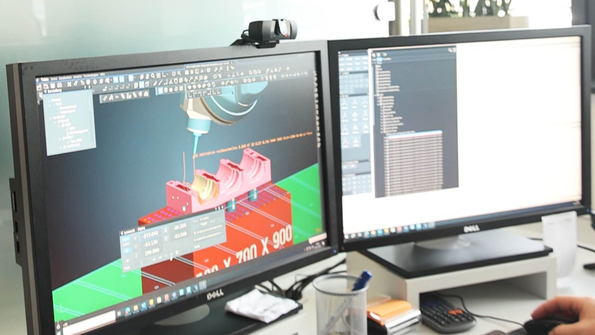 Tebis version 4.1, has become a great deal faster than version 4.0. The new graphical user interface (GUI) is also much more user friendly. For example, the programmer now has access to a true structure tree, not just a layer tree. – Photo: Pergler Media
Tebis version 4.1, has become a great deal faster than version 4.0. The new graphical user interface (GUI) is also much more user friendly. For example, the programmer now has access to a true structure tree, not just a layer tree. – Photo: Pergler MediaA wide range of Tebis modules from 5-axis milling and the trimming module to 3+2-axis milling and the 2.5D element ensure a high level of precision and productivity at Kestermann.
We work with the latest Tebis version 4.1,
explains the model maker. "The switch from version 4.0 is not an automatic process for us – after all, it makes perfect sense to use the changeover to simplify and streamline many processes at the same time. So it’s an ideal time to address and optimize them.“
Some effort is initially involved in the version change, learning the new functions, and optimization of the processes. "This has to be managed alongside our day-to-day business," the owner explains. "But the switch to Tebis 4.1 is definitely worth it – the new version’s expanded options, easier usability, and streamlined processes will pay off very quickly in day-to-day work."
Tebis 4.1 has become significantly faster
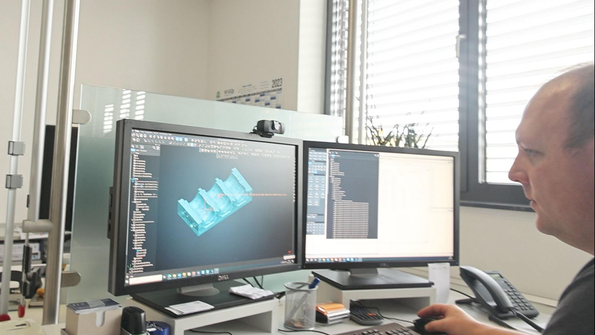 The programmers can save themselves a lot of routine work by using the programming templates. This is because the Tebis CAM software quickly and reliably detects relevant geometry features in the designed parts. The programmer only has to modify the preset database parameters for the desired geometries. – Photo: Pergler Media
The programmers can save themselves a lot of routine work by using the programming templates. This is because the Tebis CAM software quickly and reliably detects relevant geometry features in the designed parts. The programmer only has to modify the preset database parameters for the desired geometries. – Photo: Pergler MediaUser benefits include more efficient algorithms in the CAM software.
Tebis version 4.1 has become a great deal faster than version 4.0,
Kestermann says. "The new GUI is also much more user friendly." For example, the programmer now has access to a true structure tree, not just a layer tree. "Improvements like this," the programming expert adds, "also make traceability on the workpiece much more transparent."
Tebis has also significantly improved the automatic programming features in the new version. The possibilities for extensive automation of programming steps are based on the software clearly and uniquely identifying geometric features of a designed part. Ultimately, standardized production processes and consistent classification of the parts enable machinists to apply similar process steps to workpieces with similar geometries.
Improved feature selection
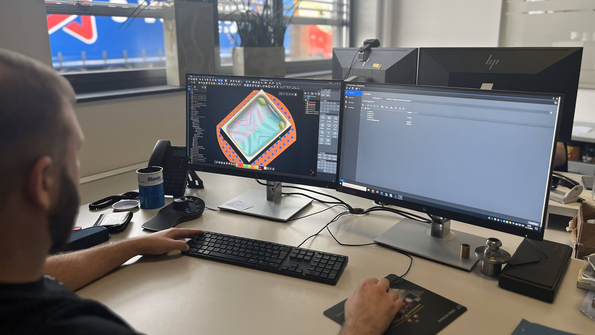 The model and mold makers managed a complete but very fast transition – thanks in no small part to the support from Tebis. They also invest in approximately 10 training days a year with the Tebis team. The pertinent knowledge is conveyed in comprehensive, concise, and practical on-site training, and the new insights can be applied immediately in day-to-day work. – Photo: Kestermann
The model and mold makers managed a complete but very fast transition – thanks in no small part to the support from Tebis. They also invest in approximately 10 training days a year with the Tebis team. The pertinent knowledge is conveyed in comprehensive, concise, and practical on-site training, and the new insights can be applied immediately in day-to-day work. – Photo: KestermannThe Managing Director is convinced that Tebis has once again taken a big step forward with version 4.1,
especially with regard to the automation functions. "For example, automatic feature selection was not yet as clear and efficient in version 4.0. With Tebis 4.1, we believe we are very well positioned, especially in this area."
Together with the highly proficient experts from Tebis, Kestermann's team has defined strategies to specify how to machine different geometries. These are important steps, because the more detailed the work of those responsible, the better and more efficiently Tebis can ultimately automate the programming of these parts. The "templates", or NCSets, that Tebis provided in earlier versions have been further optimized in Tebis 4.1.
Automated programming is further optimized
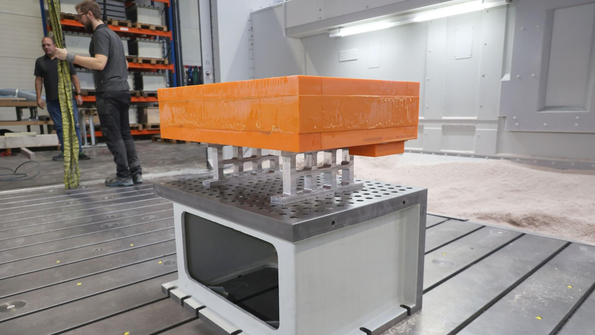 In addition to the machines, cutting tools, clamping devices and fixtures, the blanks are also precisely measured at Kestermann and represented in the system as virtual twins. This ensures the programmers can simulate operations using real data and the results from the software precisely correspond to reality. – Photo: Pergler Media
In addition to the machines, cutting tools, clamping devices and fixtures, the blanks are also precisely measured at Kestermann and represented in the system as virtual twins. This ensures the programmers can simulate operations using real data and the results from the software precisely correspond to reality. – Photo: Pergler MediaBy using these programming templates, the programmers can save themselves a lot of routine work. This is because the Tebis CAM software quickly and reliably detects relevant geometry features in the designed parts. The programmer only has to modify the preset database parameters for the desired geometries. Everything else is covered by the refined algorithms in the software.
For example, the CAD data is color-coded – whether it comes from the company's own design department or from designs provided by the customer. The colors provide essential information, such as whether a feature is a fitting bore, a free-form surface, or a thread. "This allows the programmer to spend more time on optimizing the program, placing clamping devices, or closing missing surfaces," Kestermann summarizes.
Tebis 4.1 has made specific tasks, such as correcting surface errors and closing “gaps” in the imported data, extremely simple and efficient.
Libraries enable automated programming
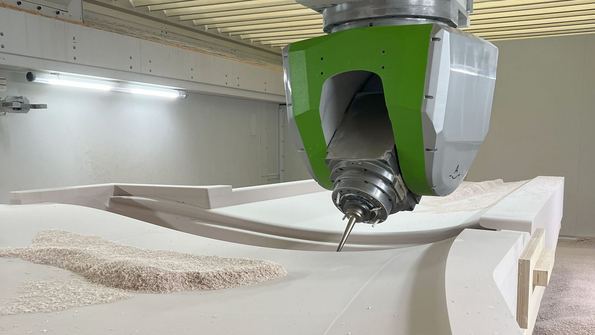 The newly acquired Zimmermann 5-axis FZ37 CNC gantry milling machine extends the range of parts Kestermann can produce up to dimensions of 7000 x 3500 x 1750 mm. In terms of materials, the machinists use almost everything on their machines, from wood to relevant model and mold-making plastics, aluminum alloys, and common tool steels. – Photo: Kestermann
The newly acquired Zimmermann 5-axis FZ37 CNC gantry milling machine extends the range of parts Kestermann can produce up to dimensions of 7000 x 3500 x 1750 mm. In terms of materials, the machinists use almost everything on their machines, from wood to relevant model and mold-making plastics, aluminum alloys, and common tool steels. – Photo: KestermannComprehensive libraries, as well as standardization, are other important factors. The first step is to register and record, in detail, the previously standardized cutting tools with their geometries, cutting edges, and parameters matched to a wide variety of materials. At Kestermann, this is done by default for all cutting tools on a Haimer Microset tool presetting system.
Here, all of the tools are shrink-fitted into the holders and are precisely measured and recorded,
Kestermann explains. "This is currently still a stand-alone solution, and we have to manually transfer the data to the Tebis libraries. We want to automate this eventually; soon the data will be transferred electronically, directly from the Haimer system to Tebis." This will avoid unnecessary work and eliminate a potential source of errors.
Making optimum use of the workspace
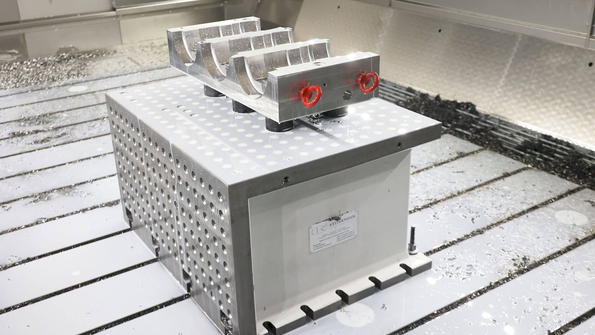 The clamping cubes Kestermann produces and markets as an in-house product are also precisely measured by the machinists and that actual data is imported into the system. The tool, model and mold makers not only work with single setups, as in this case, but also with multiple setups, where the data has to fit precisely. – Photo: Pergler Media
The clamping cubes Kestermann produces and markets as an in-house product are also precisely measured by the machinists and that actual data is imported into the system. The tool, model and mold makers not only work with single setups, as in this case, but also with multiple setups, where the data has to fit precisely. – Photo: Pergler MediaIn addition to the tools, machinists are currently in the process of recording the clamping devices.
We're just now building up our library with the precise data,”,
Kestermann explains. "We're using the manufacturers' data for our clamping elements from Schunk and SMW Autoblock, measuring our own clamping cubes, which we also market as our own product, and we’re importing the precise data into the system. We also work a lot with multiple setups – the data has to be perfect for this."
And of course the digital twins for the processing machines are also incorporated into the databases. "Nowadays, nearly every machine manufacturer provides a data set of the machine as a digital twin with its machine," explains Kestermann. "However, these are standard models that do not necessarily reflect the reality of the delivered machine to the required degree of precision. Because every machine is unique and the wall of the machining space can deviate from the standard model by a few tenths of a millimeter."
The first attempt must be a success
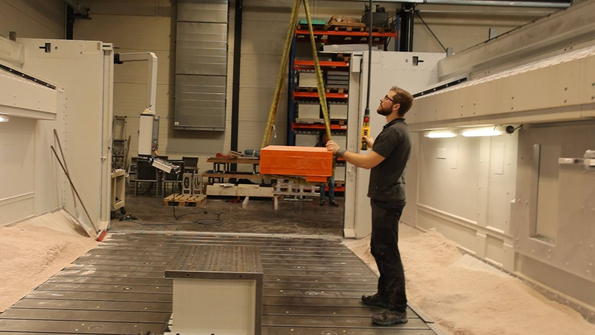 Kestermann manufactures a very wide range of parts. The company’s model and mold-making specialists can handle dimensions ranging from 100 x 100 x 100 mm to 7000 x 3500 x 1750 mm. – Photo: Pergler Media
Kestermann manufactures a very wide range of parts. The company’s model and mold-making specialists can handle dimensions ranging from 100 x 100 x 100 mm to 7000 x 3500 x 1750 mm. – Photo: Pergler MediaDeviations here could prove fatal, because those few tenths of a millimeter might be valuable space a programmer would like to use. In order to reliably work with actual data, the Emsdetten-based company had its machining centers completely rescanned by the CAD/CAM manufacturer's measurement specialists, who then updated the digital twins to reflect the actual status of the individual physical machines. This means that programmers can be sure that the "air" in the simulation is actually "air" in the machine’s workspace. The blanks placed in the machine are also precisely measured.
"We often receive orders for quantities of one, which means the first attempt has to be exactly right,"
Kestermann stresses. "For this reason, no program goes to the machine until it has first been simulated in Tebis. For us, one of the most important functions is the collision check – we don't start machining until we are certain that there won't be any unpleasant surprises. With optimal cutting data. This way we can be certain that the milled parts precisely correspond to our specifications."
Reliable machining, even unattended
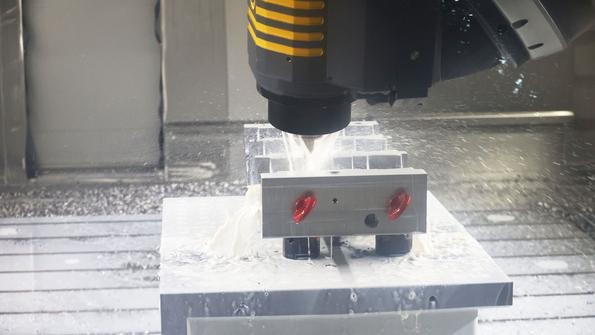 The goal at Kestermann is unattended milling of the workpieces, for instance at night and on weekends. This requires stable processes and mature, collision-free programs. The programmers can no longer imagine working without a digital twin and a virtual machine, especially considering the parts that are sometimes highly sophisticated. – Photo: Pergler Media
The goal at Kestermann is unattended milling of the workpieces, for instance at night and on weekends. This requires stable processes and mature, collision-free programs. The programmers can no longer imagine working without a digital twin and a virtual machine, especially considering the parts that are sometimes highly sophisticated. – Photo: Pergler MediaProblems with limit switches at the Emsdetten-based die, model and mold makers are now a thing of the past. And even with large parts, highly precise and reliable machining with tilted axes is now a routine matter, thanks to the simulation. The goal is unattended milling, for instance at night and on weekends. This requires stable processes and mature, collision-free programs.
We can no longer imagine working without a digital twin and a virtual machine, especially considering our parts that are sometimes highly sophisticated,”
says the programming expert. "Without simulation, any complex machining operation would be going out into the unknown – with an uncertain outcome. The fact that we can be certain of optimum machining results in advance is an important factor for competitive work." Here, too, the new Tebis 4.1 version stands out with an extended and optimized range of functions.
A fast but very thorough transition
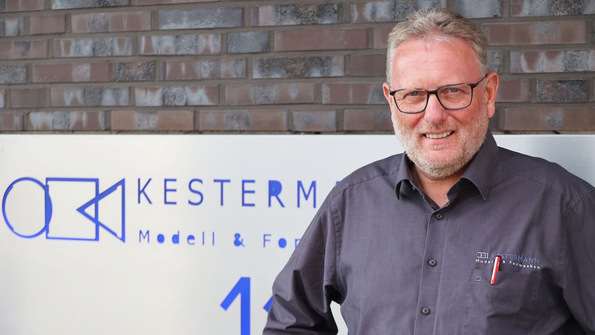 Managing Director Christoph Kestermann: "We have a good relationship with the application engineers at Tebis, we discuss matters as equals, and our requests, suggestions, and challenges are also taken seriously." – Image: Pergler Media
Managing Director Christoph Kestermann: "We have a good relationship with the application engineers at Tebis, we discuss matters as equals, and our requests, suggestions, and challenges are also taken seriously." – Image: Pergler MediaThe productivity specialists in Emsdetten managed a complete but very fast transition – thanks in no small part to support from Tebis.
We have a good relationship with the application engineers, we discuss matters as equals, and our requests, suggestions, and challenges are also taken seriously,”
says the entrepreneur.
"We invest in approximately 10 on-site training days a year with the Tebis team," Kestermann explains. "That helps us make good progress every time. The knowledge is conveyed in comprehensive, concise, and practical on-site training, and we can immediately apply the new insights in our daily work. And because Tebis’ highly experienced experts have seen almost every possible error before, we don't have to reinvent each and every wheel. That saves us from a lot of expensive lessons. That’s why we feel that we’ve made a very good investment of our time and money here."
Richard Pergler
Profile
Kestermann Modell- und Formenbau
Christoph Kestermann founded the company headquartered in the heart of Westphalia. The company’s goal is to support the automotive sector, foundries, industry, and the manufacturing sector with first-class technical solutions for individual production. At the heart of the company is a motivated team of approximately 30 employees, (including two trainees, who have made it their goal to develop solutions that perfectly meet the requirements of their customers. It goes without saying that the company delivers the highest quality and is fully committed to its customers. The managers attach particular importance to individuality and reliability. And all this with customized solutions delivered on time. The experienced specialists in model and mold manufacturing, NC machining, die manufacturing and measurement engineering, as well as the use of state-of-the-art machines and a high degree of expertise, ensure smooth handling, even for complex projects.Focus
Structure tree
Tebis 4.1 offers users the option of performing their work entirely in a practical structure tree. The benefit: All activities are traceable at all times. The structure tree is subdivided into CAD and CAM areas. The CAD node contains the CAD elements: If parts are imported from another system, Tebis immediately provides a precise overview of the input data. If a part is designed in Tebis with parametric/associative design, the entire creation history is also visible in full detail. Similarly, the CAM node in the tree contains the Job Manager. Users can access all CAM information, such as NC machining and NC sequences, and can directly apply functions relevant for manufacturing. Another major benefit is the personalized user interface: Users can precisely adapt toolbars and structure trees to their individual tasks and requirements.Perspective
Intelligent use of existing knowledge
When it comes to CAD/CAM software, many companies are overlooking valuable untapped potential. The programs are constantly evolving, gaining new functions, and becoming increasingly powerful. But how can this knowledge reach the employees? Of course, you can learn the hard way by figuring out everything on your own, by making mistakes that are unnecessary – because others have already made them many times over. That's why Kestermann's decision to give the team regular training with Tebis is a good one – it’s time and money well spent, because employees are immediately brought up to date without any annoying "background music", thanks to the expertise of the Tebis specialists, who already know almost all the mistakes that can be made.
